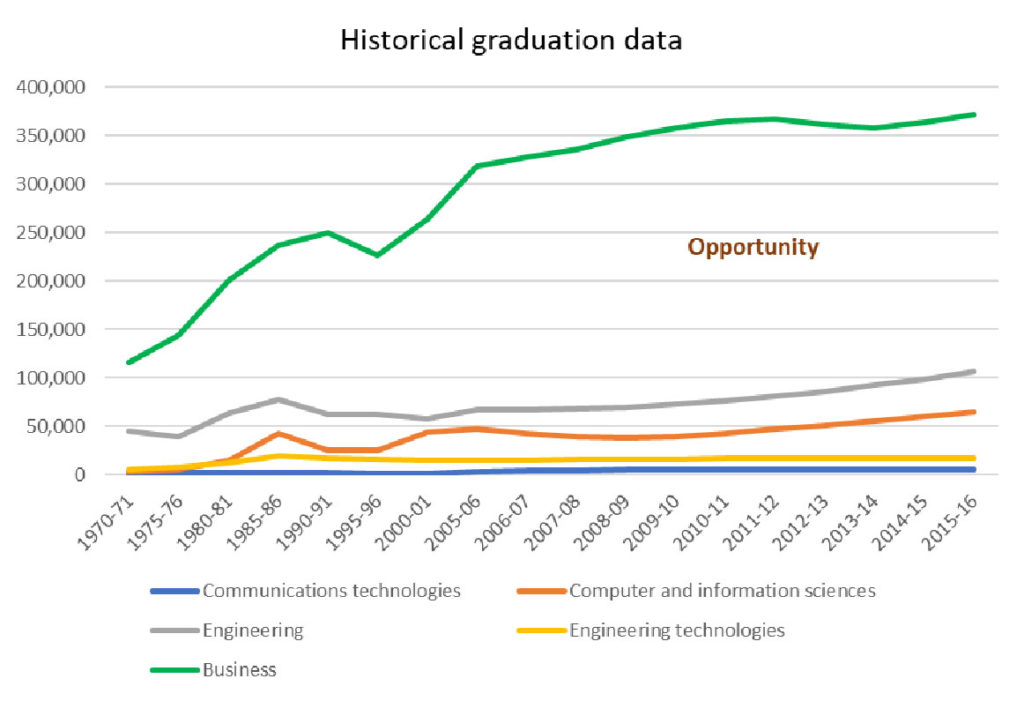65% of tech leaders confirm the hiring challenge, a 6-point increase over last year*
83% of tech managers agree to the shortage**
Are you hearing this in your conversations regularly? If so you are not alone

These are the common assertions that have been leveled at the tech talent demand in the country, and the recent visa regulations have only amplified these woes. Multiple surveys, whitepapers, and reports have all agreed with this over the last several years. However, Forrester Research came out with its shocking analysis that the shortage is a myth and ascertains that the supply & demand relationship is currently healthy, and that some of the issues arise from a dysfunctional education system. We believe that there is truth to both these analyses, but think that it is always good to err on the side of caution. While a shortage could definitely impact technological advancements in a country that is proud of its innovative culture, we agree that there is a lot that technology leaders can do in the coming years to address this concern.
Our technology leaders are among the best in the world and they are all in for innovation and growth, they thrive to stay relevant in an ever-changing technology landscape by adapting themselves at a pace that is unseen in anywhere else, but yet when it comes to talent, change seems to be put on the back burner. The tendency to over-rely on traditional HR as the sole adviser seems to be the best path, but the deafening silence on the topic of being creative in acquiring talent is scary, and will be disastrous by the next decade if we don’t do anything. Now is the time for the business to be a partner on talent.
While the world sees this as a challenge, we prefer to look at this as an opportunity to be creative and disruptive. Opportunities are abundant, but need to get your talent goggles on to see this. We still believe that the younger generation will play a big part in solving this issue, but want to highlight some traditional strategies to give you a holistic view.
- Workforce Planning: This is the most important aspect of the solution. Businesses need to put more time and effort to get this out at least a year ahead of time for the technology vertical in an organization.
- Compensation: As demand for these niche skills skyrockets, salaries will tend to go up, so a well thought out salary structure will be necessary. A caveat here is to be careful about throwing the sink at these candidates because an overblown compensation can break the market caps for these skills in a few years and create compression challenges for the industry. We suggest a broader compensation strategy that may include perks or other benefits, like remote working, telecommuting, and result based incentives.
- Employee Engagement: Keep your employees happy, engaged, and challenged in their work as they are your eyes and ears for outside talent.
- Career Path: Build a comprehensive path for these technical innovators. Provide them with growth opportunities that is on par with a management track, but also with hands on technical work (don’t lose valuable technology skills with growth).
Small opportunities are often the beginning of great enterprises – Demosthenes
There are multiple ways to be creative in approaching the perceived shortage of talent in the technology sector. It is what we look for while pipelining these specialized candidates. We are going to show you a few data points to explain why you should think beyond the norm.
Utilize Business Major Graduates
Looking at the historical data on graduating classes, the annual growth in graduates in the technical fields has remained consistent or limited. This means that we have the same availability of tech talent through the higher education system, and depending only on this source will not solve your shortage issue. We suggest you to think in terms of numbers, and you will see that business majors are on the rise. Have you ever thought about utilizing this type of talent in the technology space? If not this is the time to start and cultivate this pool to be your next wave of potential hires. They may not be coders or technologists, but can be extremely valuable on the data side of technology. They’re potential data analysts, who could be particularly useful working with data visualization, big data, PMs and many other areas. This may not create a solution for core technical needs, but will help you in reducing dependence on core technologists for these jobs, freeing them up for more specialized tasks.

Underemployed
We are all well aware that the current unemployment rate for the technology sector is at a really low level, which is leading to the supply challenge perceived in the industry. This is a reality and we need to embrace it. Based on the latest American unemployment data you will see that though unemployment rate is low, the level of the underemployment is quite high. This is across all academic majors so there is a substantial talent pool in the underlying data of underemployed graduates that you can tap into. These are people who have taken up jobs outside their field of comfort due to the market conditions. We need to delve into these people, and this means talent teams and managers will have to be creative in their approach, and start deeply looking at education background while pipelining candidates, and be careful not to create impressions based on experience.

SkillsHub:
The shortage of skilled talent in technology is a challenge faced throughout the world, but on a positive note there are locations where the availability of certain technology talent is far more than the demand, and you should be looking at ways to get this valuable talent on your side in order to be competitive. If the “talent does not come to you, you go to the talent.” So let’s introduce the concept of a “Skillshub.” It is a concept driven by the needs of an organization. With rapid technology changes this might be the path to go to get the quality of talent you deserve. The world is your location and a hub can be established anywhere where there is a decent supply of candidates for your needs. This can be done by hiring on your own, which is easier said than done, or it may be built and maintained.
Written by Harish Nair, Principal Talent Partner for HARP Talent Solutions. Are you looking for solutions to attract top tech talent? You don’t just need a recruiter, you need a partner. Connect with us today to learn more.
Sources:
NY Federal Reserve bank: https://nyfed.org/1VvCrtJ
National center for education statistics: https://bit.ly/2J3YCrM
Forrester Research: https://bit.ly/2E7zoFs
* Harvey Nash/KPMG Survey: https://bit.ly/2tIdkjr
** Indeed Survey: https://indeedhi.re/2hBdovH
U.S. Census Bureau, American Community Survey (IPUMS); U.S. Department of Labor, O*NET.
